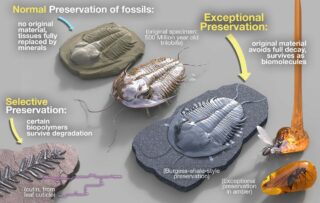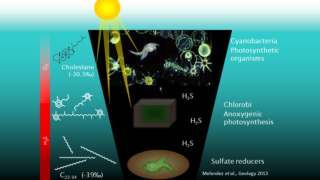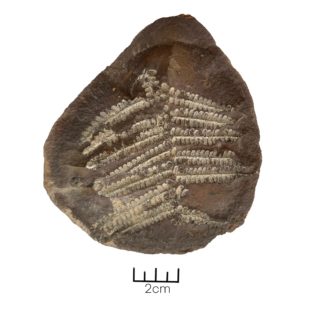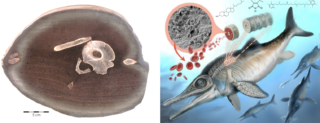Molecular palaeontology

When organisms die, hard body parts such as bones and teeth may be mineralised into inorganic fossils. Most soft tissues are rapidly degraded, with typically little organic material surviving. However, in some exceptionally preserved fossils (e.g. those sequestered within concretions) the degradation of organic matter appears to have paused early in the fossilisation process, contributing to the prolonged preservation of soft tissues or articulated skeletal remains. Protection against the environment through rapid cementation and entombment can prevent the complete mineralisation of soft tissue and organic molecules. Simple organic molecules (natural products) such as lipids and pigments can remain intact for > 1 billion years in ideal conditions and modified protein residues (which can be used to distinguish closely related species) can persist for 4 million years.

‘Selective’ preservation of recalcitrant biopolymers: Certain extremely resistant biopolymers, such as in higher plant leaf cuticles and the cell walls of marine and freshwater algae, are relatively persistent in geological sediments. High-molecular-weight, aliphatic biomolecules are some of the more recalcitrant organic compounds.

‘Exceptional’ preservation of fossils: Under ideal depositional conditions, organisms can be rapidly preserved in concretions (anticipated to be within months based on pilot data), protecting organic matter from degradation and allowing `closed system´ preservation of soft tissues. Whole or parts of organisms can be preserved by several pathways, such as carbonaceous compressions in pyrite or apatite; entombment or primary cementation in concretions of calcite, siderite or dolomite. Specific processes favouring preservation include rapid burial, negligible bioturbation, slow decaying processes, limited scavenging due to anoxic/euxinic conditions and rapid entombment of sedimentary horizons by, for example, microbial communities and early diagenetic cements.

Microbial communities can form concretions that can contain intact fossils. We have been studying the role of microbial communities, in particular Chlorobi (green sulfur bacteria) and sulfate reducing bacteria, through analyses of their biomarkers e.g. isorenieratane and maleimides. In fact we have observed the entire diagenetic continuum of sterols to steroids (70 components) in a Crustacean fossil encapsulated in a 380 million year old concretion from the Devonian Gogo Formation, Canning Basin, WA associated with the end-Devonian mass extinction event. We attribute the coexistence of steroids in a diagenetic continuum to microbially mediated eogenetic processes in the water column.
We are investigating a range of fossil concretions from worldwide locations.
Example publications
Plet, C., Grice, K., Scarlett, A.G., Ruebsam, W., Holman, A.I., Schwark L. 2020. Aromatic hydrocarbons provide new insight into carbonate concretion formation and the impact of eogenesis on organic matter. Organic Geochemistry 143, 103961. https://doi.org/10.1016/j.orggeochem.2019.103961
Grice, K., Holman, A.I., Plet, C., Tripp, M. 2019. Fossilised biomolecules and biomarkers in carbonate concretions from Konservat-Lagerstätten. Minerals 9, 158. https://doi.org/10.3390/min9030158
Plet, C.L., Grice, K., Pages, A., Verrall, M., Coolen, M. J. L., Ruebasm, W., Rickard, W. D. A., Schwark, L. 2017. Palaeobiology of red and white blood cell-like structures, collagen and cholesterol in an ichthyosaur bone. Scientific Reports 7, 13776. https://doi.org/10.1038/s41598-017-13873-4
Lengger, S.K., Melendez, I., Summons, R.E., Grice, K. 2017. Mudstones and embedded concretions show differences in lithology-related, but not source-related biomarker distributions, Organic Geochemistry 113, 67-74. https://doi.org/10.1016/j.orggeochem.2017.08.003
Plet, C., Grice, K., Pagès, A., Ruebsam, W., Coolen, M.J.L., Schwark, L. 2016. Microbially-mediated fossil-bearing carbonate concretions and their significance for palaeoenvironmental reconstructions: A multi-proxy organic and inorganic geochemical appraisal. Chemical Geology 426, 95-108. https://doi.org/10.1016/j.chemgeo.2016.01.026
Melendez, I., Grice, K., Schwark, L. 2013. Exceptional preservation of palaeozoic steroids in a diagenetic continuum. Nature Scientific Reports 3, 2768. https://doi.org/10.1038/srep02768
Melendez, I., Grice, K., Trinajstic, K., Ladjavardi, M., Thompson, K., Greenwood, P.F. 2013. Biomarkers reveal the role of photic zone euxinia in exceptional fossil preservation: An organic geochemical perspective. Geology 41, 123-126. https://doi.org/10.1130/G33492.1
